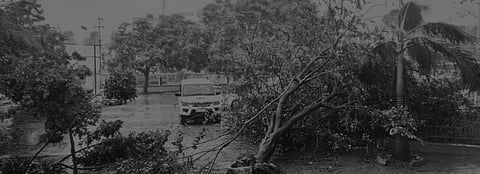

Even five days after the extremely severe cyclonic storm Fani lashed out at Odisha, the state seems to be crippled. Extensive areas, including Capital Bhubaneswar, are still limping back to normalcy as daily essentials remain scarce.
On May 7, 2019 afternoon Chief Minister Naveen Patnaik claimed that power supply was restored to a fifth of Bhubaneswar within 72 hours of the cyclone. Several residents, however, disagreed.
Cyclone Fani, with wind speed of about 175 kilometres per hour, was the second-most powerful cyclone to have hit Odisha. Nearly 50 people lost their lives due to it, according to unofficial estimates. The government, however, earned international praise for its efforts to reduce casualty by shifting away more than 11 lakh people.
No power
Though human lives were saved, destruction could not be avoided in the eastern districts, especially in and around Bhubaneswar, Cuttack, Khordha and temple town Puri. Reportedly, more than 1.5 lakh electricity poles fell and high-tension transmission lines broke down.
The storm also uprooted lakhs of trees. In Bhubaneswar alone, some estimate, some two lakh trees fell. “The city looks devastated with fallen trees all around,” said PR Sahu, a Bhubaneswar-based media professional.
Many of the trees fell on transmission lines, further complicating the situation. As CM Patnaik made it clear, it would be risky to resume power supply before removing them. Thousands of personnel have been deployed to clear the power lines.
“Power supply hasn’t been restored even now. It’s as if we are living in primitive ages,” Sahu said even after the CM’s tweet.
In the absence of electricity, water supply has also been affected. The Bhubaneswar Municipal Corp (BMC) has been running generators to pump water once in the morning to houses with piped connection.
In Puri, even that has been out of question. In fact, most of Puri has remained out of reach.
Even for Bhubaneswar, the measures were inadequate. “We have also arranged for water tankers for areas that do not have water,” said a civic official. Every day, 200-300 people were calling the Bhubaneswar One helpline to complain regarding power and water supplies and other necessities.
The water supply can be normalised only when the power supply becomes stable, added the official. That would take another two-three days, he estimated, with several 33 kilovolt (kv) and 11 kv lines still in disarray.
That would surely add to the pressure of those living in these cities, with daily essentials getting scarcer.
It must be said here that the chief minister’s office tried to reassure citizens:
Moving base
Some have already started leaving their homes. “A friend of mine has moved to a hotel temporarily,” Sahu said.
Many others have left Bhubaneswar for smaller cities and towns such as Kendrapara, Jajpur, Dhenakanal and even far-off Sambalpur, said JP Mahapatra, associated with a national-level media training institute. “They are commuting daily to their workplace in Bhubaneswar,” he added.
Mahapatra himself moved his family away from the Capital’s Acharya Vihar on May 6. “There was no other way. A litre of water was selling for Rs 70. Most markets remained shut and only a few shops opened for a few hours during the day,” he said.
Thanks to its smart city status, there are hardly any public tube wells left in the city, he added.
Prices skyrocket
The shortage, coupled with suspected hoarding, meant prices of essentials were sky-high. “I have heard that even a packet of candles is selling for Rs 120 — triple the marked price,” social activist Ranjan Panda said.
Though relief was being arranged for by the government and several non-government organisations, there have been complaints of the material often not reaching those in need. “There even have been reports of loot from some places near Puri,” Sahu said.
The residents of a locality in Bhubaneswar blocked the road on May 6 to press home their demand for water, Panda said. “Those with their personal borewells are somewhat better off,” he added.
But then generator sets to pump such motors have also become hard to come by. “Stockists in Sambalpur also claim that they have run out of generators. Some are renting them at steep prices,” he added.
While the locals have a chance to receive relief or leave for nearby towns, many outsiders are stranded, Panda pointed out. Neither do they have access to any relief, nor do they have any cash.
Most automated teller machines have run out cash. With mobile telephone and internet services down, internet banking is also out of the question for such visitors. “The first priority should actually be to restart mobile networks. In their absence, the government is not even able to reach out and mobilise people,” Mahapatra said.
As Bhubaneswar readies for another dark night ahead, the question in the mind of those who have stayed back must be: “How much longer would it take?”